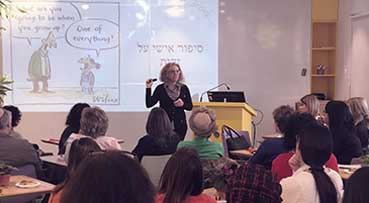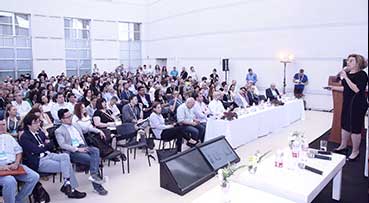The younger generation is searching for work that is full of meaning, learning, professional development, and flexibility. There is no reason why public service can’t offer this type of work. Herein lies an opportunity – and you can take it now.
The Ministry of Defense is shocked: young engineers don’t want to work. This sentence, a title of an article that was recently published in The Marker (in Hebrew), could be a great opportunity to discuss the important implications that the pandemic has brought to the world of work and to public service. Instead, the article gravitated toward salary-matters as well as all the challenges that accompany competing for talent with high-tech firms.
However, in non-high-tech sectors, including the public service, focusing on wages diverts the debate from the real issues that make it difficult for the public sector to recruit workers. It is not only about salaries. Today we would like to look beyond just the salary factor to understand why public service is not attractive to the talent that this sector would like to employ.
It is in all our benefits to make public service an appealing employment sector for the new generation of employees – those who can bring innovation and new skills and help the services evolve to the new, rapidly changing digital era. According to OECD research from 2017, around a quarter of employees in public service in Israel are above the age of 55, and half of them are between the ages of 35-54. This is a thought-provoking statistic since the aging of the workforce in this sector indicates simultaneously a challenge and an opportunity. On the one hand, we need to ensure that the large number of employees soon to retire will not affect the knowledge and quality of services. On the other hand, there is an opportunity to bring people with new perspectives. So the sector’s inability to recruit young talent risks its ability to innovate and generate fresh ideas.
The younger generation of professionals constantly increase expectations for employers: they look for work high in social significance with clear ways to positively impact society and the world. The ability of civil service to offer jobs that meet this need is high, and it is important to remember this aspect while attempting to attract new employees. That being the case, why is it still so difficult for this sector to hire young talent?
Adoption of Technology and Innovation
The new generation brings with it a great deal of tech skills along with the expectation that these skills will be utilized on the job. Moreover, they expect that the workplace will be friendly to innovation and change. However, this ambition cannot always be met in the public sector. When new workers are searching for an employer, they ask themselves “where can I build my career and experience ensuring that the required skills will stay relevant in the changing job market?” Since the private sector is much more friendly to new technology adoption, and is more agile in doing so, the public sector, competing for the same talent, struggles.
The report of UK-based Accenture indicates that employees in the public sector, who used technology to improve their working abilities, reported much higher job satisfaction than those who did not. Now, following the pandemic, innovation has penetrated work processes of every industry. The public sector has a great opportunity to finally reduce the technology utilization gap with the private sector. It is not only that the flexibility of work hours and work locations has become commonplace; the acceptance of innovation in processes, tools, and infrastructure of every workplace has also changed.
Professional Development and Learning
In the changing world of work, young employees know that they need to stay up to date all the time. Organizations are beginning to understand that they need to help keep their employees relevant for future jobs even while doing current ones. That’s why more and more organizations introduce reskilling (introduction of new skills and roles), and upskilling (deepening the knowledge of employees to expand roles and responsibilities) programs for their employees.
Traditionally, there is less employee mobility within public service which limits an employee’s ability to build a wide range of skills and capabilities whilst staying within the sector. A KPMG survey conducted in 2020 found that the public service sector ranked highest among all industries in its need for retaining its people’s skills for the new technological era. The above research by Accenture also highlights that while more than 86% of public service workers feel that they do something meaningful – one of the highest rates across industries – many of them feel that they have more ways to contribute, and only 50% feel that they fully realize their potential at work. These results clearly indicate insufficient attractiveness of the public sector as an employer.
Employee development in the public sector is very important in helping to retain skills and knowledge. One possible solution is to simplify lateral moves between various government agencies or jobs in order to enable redistribution of human resources according to most up to date employer priorities, thus enabling career growth. One of the inherent advantages of large organizations is their ability to enable employees to build a whole meaningful career in one organization by moving between roles and areas of interest, and by developing both personally and organizationally. Currently, this is not the case. Lack of transparency of jobs availability and mobility does not allow government workers to move without compromising salary, tenure and pension.
Flexibility
In the business sector, organizations learn to adjust structures, management approaches, and work styles to operate in the changing and unpredictable world. This is not always done by choice, but from understanding that they have no other way to survive. These processes constantly redefine the norm for employees in the world of work.
Flexibility is not only about working from home. It implies all that has to do with where, when, how and who we can work with; it defines expectations of employees from their managers and organizations and their ability to combine work with the rest of their life. This flexibility includes, for example, a trend of movement from hierarchical to network-driven work structures that enable people to work based on their ability to contribute, and not just on their seniority, position or rank. Another example of such flexibility is when jobs and roles are redesigned, adjusting both the content and the scope, to better match the people who hold those responsibilities and relevant skills.
Trust-Based Culture
As we shifted to remote work during the pandemic, trust, or lack thereof, became central to how we work. We learned that when we listen and aspire to meet the needs of our people, we receive their trust and loyalty to the organization, and eventually their commitment and contribution.
Changes in the ways we work require managers to learn managing work even if it’s done remotely. We adjusted and now measure and reward work done, not hours worked or level of experience. In this process, we need to let go of our need to see people at their desks and start managing them, assuming that even if they work elsewhere, they do work. And then deal with the exceptions.
Public service competes for talent with the private sector. Business organizations are constantly evaluating and coming up with new ways to attract and retain employees. Government offices need to be on alert and listen closely to what the employees they want to attract expect from them. Apparently, this includes enabling hybrid ways of working, various forms of flexibility, better exposure to new technologies and systems, and constantly improving employee experience with transparency and trust.

![large-AX1A2125-2[1] large-AX1A2125-2[1]](https://niritcohen.com/wp-content/uploads/elementor/thumbs/large-AX1A2125-21-pnzedcs72atx5aeurqytqdiihxixlq02re9mlz805s.jpg)






